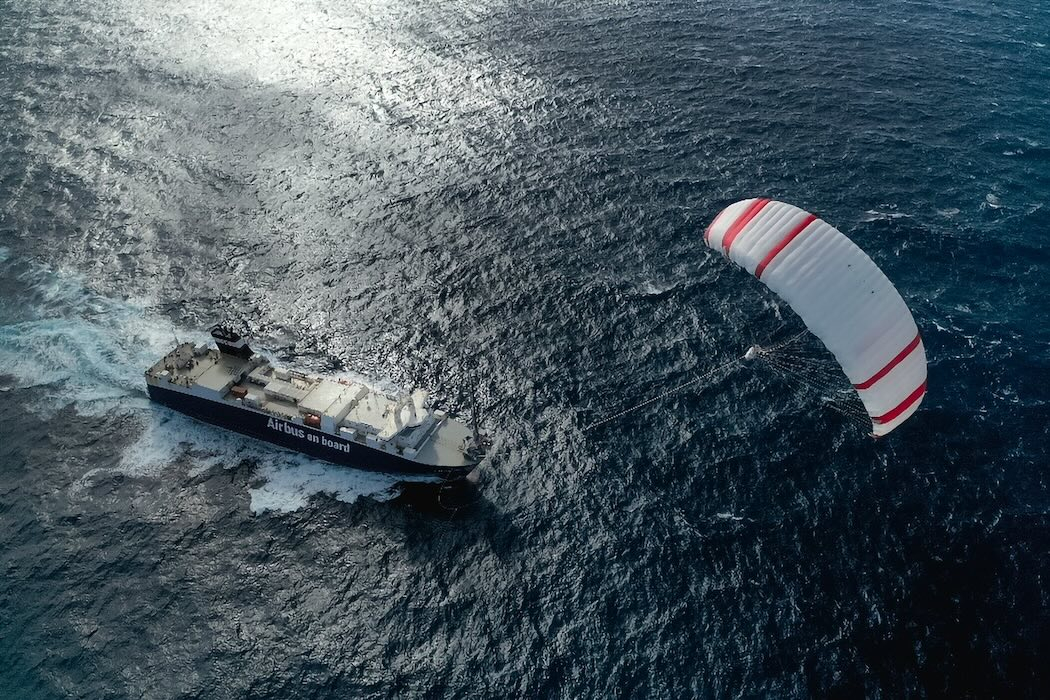
Photo credit: polaRYSE
The SEAWING4BLUE project, is a two-year project, co-funded by the European Union and is directly linked with Pillar I of the Atlantic Strategy objective of the transition to carbon-free economy by tackling the emergency on decarbonizing shipping and supporting the scaling up of the next break-through sustainable alternative to fossil energy in the shipping industry. This project will elevate the use of renewable energy – wind and will contribute to set up standards and regulation specific to wind propulsion as well as methods to measure the performance of wind propulsion. More specifically, it aims at maximising the power of wind through the product Seawing, a large wing structure, flying at a high altitude capturing a more stable wind for propulsion of the vessel. The serial Seawing, developed by the start-up Airseas, will be an integrated system composed of a 1000 square meters kite wing controlled by a pod, a deck structure including a 36 meters high mast to deploy the wing and a storage tank, as well as software technologies to control the flight automatically (digital twin technology) and to help the crew in routing the ship (ecorouting software).
The innovative technology of the Seawing
After a proof of concept in 2017, a first order in 2018 by Airbus, and a long-term collaboration contract with a major Japanese shipowner ‘K’ Line in 2019, the company conducted many tests and trials in 2020 and 2021, with various sizes of wings and on different testing grounds, mainly on the shore. In May 2021, a first large scale test on the sea was conducted off the coast of Sète, South of France, on a barge, while the first system was undergoing manufactured. SEAWING4BLUE’s start coincided with the first complete Seawing system leaving the factory and being installed on the port of La Rochelle for final ground trials before its installation on the Airbus’ vessel.
Seawing was installed on a first vessel in December 2021, the Ro-Ro Ville de Bordeaux owned by Airbus and operated by Louis Dreyfus Armateurs. The system is now undergoing final trials in the sea, in real commercial conditions, and is being tested for a period of a minimum of 6 months, on several journeys between France and the United States. The final wing fitted for the 154m Ville de Bordeaux is a 500 sq meters wing, a final development step before scaling up to the serial product’s size. A team between 10 and 12 engineers and technicians is taking shifts onboard to test and fine-tune the system, while the rest of the team works on the ground to develop the project, work on the software features and support the company. The innovative technology of the Seawing - born from the transfer of aeronautics know-how to the maritime sector - will help to lower the emissions by decreasing the fuel consumption of each vessel on average by 20%.
If we are to achieve the IMO´s goal of zero emissions by 2050, we need a hybrid propulsion system that combines the solutions available today to decarbonize the maritime sector with the alternative fuels of tomorrow.
said Stéphanie Lesage, General Counsel and Corporate Secretary, December 2021
Overall, the SEAWING4BLUE project is expected to generate 150 additional direct jobs, a portfolio of 12 patents registered worldwide by 2026 while saving 7 million of CO2 emissions per year. By 2030 it is expected that 1000 Seawings will be produced and delivered for use on vessels.
Further information on the project:
- Reference: EMFF-BEW-2020-101038256
- Project duration: 01.09.2021 - 31.08.2023
- Project locations: France
- Overall budget: €3 571 360
- EU contribution: €2 499 950 (70% of the overall budget)
- Entities Involved: Airbus, Kawasaki Kisen Kaisha ‘K’ Line, Nervures, MaxSea, ADEME, Occitanie Region, Pays de la Loire Region
If you are interested in knowing more about this project, please consult the following links:
- Official website of the project: https://airseas.com/en/seawing4blue-en/
- LinkedIn: https://www.linkedin.com/company/airseas-tech/
- Twitter: https://twitter.com/Airseas_Tech
